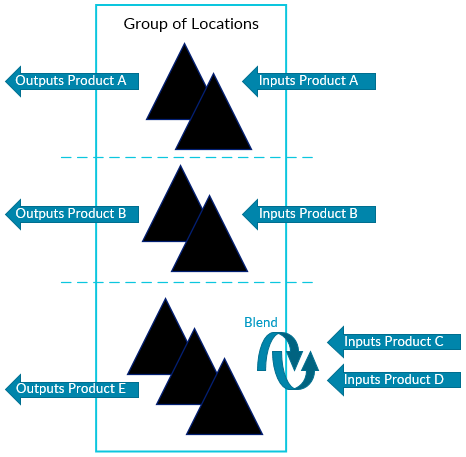Separating Products in Reconciliation
The group of locations in a reconciliation can be reconciled by products because shipments are usually separated into products.

Process of Reconciling a Location by Product
When reconciling a group of locations by product, the first step is to identify which stockpiles, process flows and transactions deal with a specific product.
An opening balance of a product is the sum of the opening balances of the stockpiles with this particular product. A closing balance of a product is the sum of the closing balances of the stockpiles with this particular product. Inputs are transactions that carry this particular product and come in the envelope, or the transactions that come in the envelope and go to the particular product stockpiles. Outputs are the transactions that carry this particular product and go out of the envelope, or transactions that go out of the envelope and come from the particular product stockpiles. After this distinction has been made, the second step is to apply the following reconciliation formula for the specific product:
Inputs (Product) - Outputs (Product) = Closing (Product) - Opening (Product) + Adjustment (Product)
Problems that Arise When Reconciling by Product
Problems can arise if a wrong process flow exists in an envelope, leading to incorrect results.

When reconciling this envelope, zircon reconciliation inputs are null because no process flow coming from outside the envelope transports the zircon product, whereas Outputs 1, closing balance and opening balance of zircon are not null. In this scenario, after reconciliation, there should be:
Inputs of Zircon - Outputs of Zircon = Closing Balance of Zircon - Opening Balance of Zircon
If the process of reconciling a location by product is used, the reconciliation result will be wrong because:
Reconciled Inputs of Zircon - Outputs of Zircon = Closing Balance of Zircon - Opening Balance of Zircon
Hence, when considering an envelope, reconciling a location by product should not be used because products can appear, disappear or be transformed in an envelope. If the previous envelope is to be reconciled by product, consider splitting the envelope into several sub-envelopes. The envelope should be reconciled without any product consideration, and then the results should be spilt by products. However, if this process is used, there cannot be different process flow separations by product and different adjustments by product. All products will get the same adjustment.
Therefore, in MineMarket, reconciliation by product is allowed, but it is the responsibility of the user to verify that the envelope configuration will satisfy the reconciliation formula for each product.
Product Groups
In some business configurations, several instances of a product are defined in the supply chain. For example, a customer decided to define Zircon A, Zircon B, Zircon C as different variants of Zircon product. In reconciliation, this same customer may not be interested in this level of detail. To solve this issue, the concept of product group is introduced. An envelope is considered to have a specific product group if at least one of the products of the group is involved in the envelope.
Stockpiles with Several Products
A stockpile can support different products over time (concept of dynamic products). With the 3D concept, a stockpile has several products at a specific time spread in various spatial locations in stockpiles. In this case, it is important to understand the reconciliation of envelopes by products or product groups:
- Static stockpile
The product is used at the time when processing the reconciliation. If the stockpile product is changed afterwards, a new reconciliation will switch to the new product as if the product has always been in the stockpile.
- Dynamic stockpile
- Opening - The product is used at the start time of reconciliation.
- Closing - The product is used at the end time of reconciliation.
- Inputs - All transactions going to the stockpiles are added when the product was active in these stockpiles.
- Outputs - All transactions flowing out of stockpiles are added when the product was active in these stockpiles.
- 3D stockpile
- Opening - The surveys of products are used at the start time of reconciliation.
- Closing - The surveys of products are used at the end time of reconciliation.
- Inputs and outputs - Products stored in transactions are used because in 3D, transactions record the carried product.

